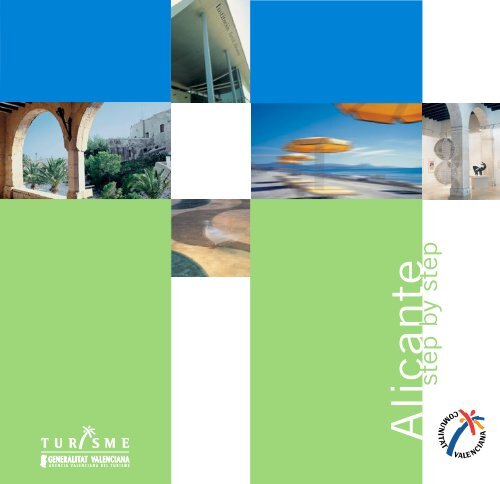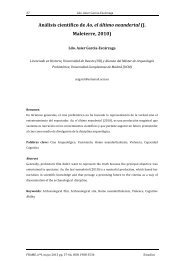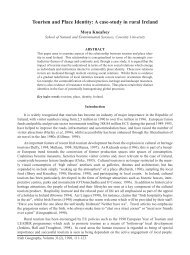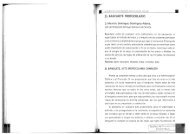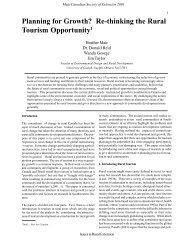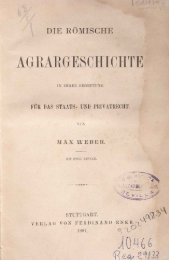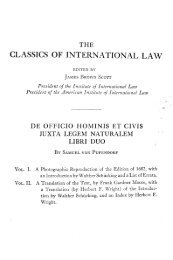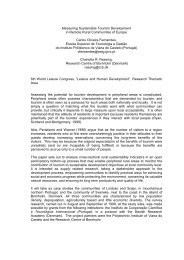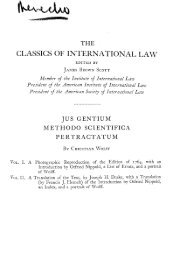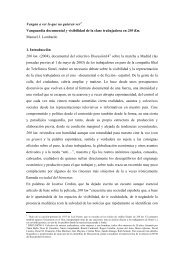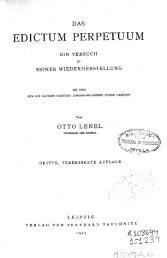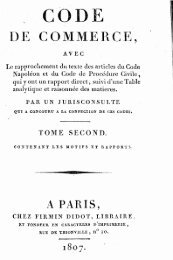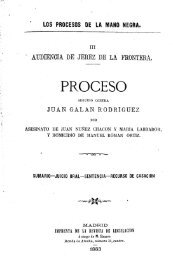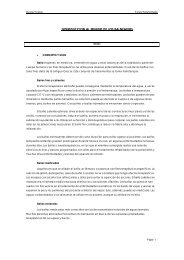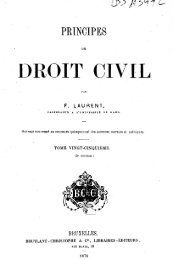Alicante Step by step - Universidad de Sevilla
Alicante Step by step - Universidad de Sevilla
Alicante Step by step - Universidad de Sevilla
Create successful ePaper yourself
Turn your PDF publications into a flip-book with our unique Google optimized e-Paper software.
<strong>Alicante</strong> <strong>step</strong> <strong>by</strong> <strong>step</strong>
<strong>Alicante</strong><br />
<strong>step</strong> <strong>by</strong> <strong>step</strong>
CONTENTS<br />
Introduction<br />
Monuments and Museums<br />
Churches and Temples<br />
Other Churches and Temples<br />
Museums<br />
Civic Monuments and Buildings of Interest<br />
Other Civic Monuments and Buildings of Interest<br />
University<br />
Parks, Promena<strong>de</strong>s and Plazas<br />
Beaches and Coves<br />
Discovering the City and its Environs<br />
The Ibero-Roman City of Lucentum<br />
The Island of Tabarca<br />
The Old Quarter<br />
The Harbour<br />
Surrounding Towns<br />
Culture and Art<br />
Festivities and Cultural Activities<br />
Business City<br />
Sports<br />
Nightlife<br />
Fiestas<br />
Mediterranean Cuisine<br />
Crafts and Shopping<br />
Excursions<br />
Along the Coast<br />
Inland<br />
Accommodation<br />
Practical Tips<br />
Tourist Info<br />
Links<br />
4<br />
6<br />
7<br />
9<br />
10<br />
12<br />
14<br />
17<br />
18<br />
22<br />
24<br />
24<br />
24<br />
25<br />
27<br />
27<br />
28<br />
29<br />
30<br />
32<br />
34<br />
36<br />
38<br />
39<br />
40<br />
40<br />
41<br />
42<br />
44<br />
44<br />
45
4<br />
If variety is the spice of life, <strong>Alicante</strong> takes the cake, however<br />
you look at it. This city with a population of over 300,000<br />
combines both classic and mo<strong>de</strong>rn, it offers business and<br />
pleasure, entertainment and educational opportunities, and<br />
manages to fit mountains and beaches within its city limits.<br />
It even has an island off the coast – the only inhabited island<br />
in the Land of Valencia.<br />
<strong>Alicante</strong> has a long history reaching back to prehistoric times,<br />
with archaeological remains having been found here from the<br />
third millennium before Christ. This is the site of an ancient<br />
Iberian urban settlement dating from the late 5th century BC.<br />
The city later became a Roman municipium, Lucentum, at the<br />
behest of the Emperor Augustus at the beginning of the Christian<br />
era. It has been a Spanish city for over 500 years, with a charter<br />
granted to it <strong>by</strong> Ferdinand the Catholic in 1490. Its title inclu<strong>de</strong>s<br />
the praiseworthy epithets of “illustrious, eminent, noble, loyal<br />
and always faithful”, bearing a gol<strong>de</strong>n fleece on its coat of<br />
arms since 1524 <strong>by</strong> permission of Carlos V. Today it is a first-<br />
rate tourist area thanks to its splendid beaches and its excellent<br />
climate, offering charm, tradition, monuments and tourist<br />
attractions, and an exciting festivities and cultural calendar<br />
throughout the entire year.<br />
<strong>Alicante</strong>’s provincial economy is strong, ranking as Spain's<br />
fourth largest province in terms of its Gross Domestic Product<br />
and number of inhabitants, plus its highly active University<br />
with 40,000 stu<strong>de</strong>nts distributed amongst the <strong>Alicante</strong> and<br />
Miguel Hernán<strong>de</strong>z faculties. This strength has given rise to a<br />
well-consolidated tradition in the field of organising congresses,<br />
conventions and professional encounters of all kinds.<br />
The 21st century and the new millennium will usher in a<br />
prosperous city in ongoing evolution, with the ad<strong>de</strong>d dynamics<br />
of being one of the offices of the European Union. It will shortly<br />
become the site of a unique theme park project called “The<br />
City of Light”. Apart from this, there is lots of local warmth,<br />
with local hospitality and cordiality rating highly, plus a<br />
multifaceted entertainment and cultural lineup – <strong>de</strong>scribed on<br />
the pages that follow – that attracts people to this city at any<br />
time of the year.
6<br />
MONUMENTS AND MUSEUMS<br />
In <strong>Alicante</strong> we can see the Ibero-Roman city with remains<br />
dating from the 5th century BC to the 2nd century AD, or<br />
choose to see some of the displays of the finest contemporary<br />
artists; one of the most advanced archaeological museums in<br />
Spain; or the largest collection of 20th-century Spanish sculpture<br />
in the world; or an imposing mountaintop castle, Gothic churches<br />
and many extraordinary examples of civic and religious buildings<br />
in the baroque style.<br />
As a new addition to <strong>Alicante</strong>'s fine selection of monuments and museums, the city is<br />
soon to open a Provincial Fine Arts Gallery inten<strong>de</strong>d to contain and preserve 19th-century<br />
paintings and other works of art now in the holdings of the provincial council.<br />
The city’s 18th-century manor houses, the typical Santa Cruz quarter with its quaint<br />
chapels, and many other monuments scattered around the urban area where travelling<br />
exhibitions are often held, are other attractions in the tourist lineup this city has to offer,<br />
ensuring that visitors will be pleasantly surprised.<br />
CHURCHES AND TEMPLES<br />
Iglesia <strong>de</strong> Santa María (St Mary's Church) tel. 96 521 60 26<br />
This is the ol<strong>de</strong>st church in the city and was built in the Gothic style between the 14th<br />
and 16th centuries over the ruins of what was once the main mosque during the Moorish<br />
domination. The solid-looking towers flanking the faça<strong>de</strong> are similar in appearance, but<br />
are in fact different in that the right tower has an original “L” shape and dates from the<br />
14th century whereas the other is rectangular and was erected in 1713. The portal is a<br />
beautiful example of sculpted baroque stonework and is attributed to Juan Bautista Borja.<br />
Of note insi<strong>de</strong> is the high alter in gol<strong>de</strong>n rococo (18th C), the choir in a very pure 14th-<br />
century Gothic style, the 16th-century Immaculate Conception chapel, with an image<br />
<strong>by</strong> Esteve Bonet (18th C), the antechoir, with a handsome baroque stone doorway, and<br />
the baptism chapel whose font in white Carrara marble is of Italian workmanship from<br />
the 16th century, attributed to the school of Michelangelo.<br />
There are many works of art kept insi<strong>de</strong> this church, of which two valuable pieces from<br />
the 15th century can be highlighted: a Gothic image in stone representing St Mary and<br />
a sculpture of the Santos Juanes <strong>by</strong> Rodrigo <strong>de</strong> Osona. There are also incunabula dating<br />
from the 13th century onwards.
Concatedral <strong>de</strong> San Nicolás <strong>de</strong> Bari (Concathedral of Saint Nicholas of Bari) tel. 96 521 26 62<br />
The outsi<strong>de</strong> of this cathedral looks highly restrained and can be stylistically placed within the<br />
framework of the later Renaissance and the early non-ornamented baroque styles. Built between<br />
1616 and 1662 following plans <strong>by</strong> Agustín Bernardino, a disciple of Herrera, it still preserves traces<br />
of the cloister dating from the 15th century, showing a smaller former temple that was built over<br />
the ancient mosque. Insi<strong>de</strong>, the cathedral is spaciously proportioned, with a <strong>de</strong>licate dome soaring<br />
to 45m above the floor. There is a fine Communion chapel, consi<strong>de</strong>red one of the most beautiful<br />
examples of the high Spanish baroque. Within the same style are the doors of the cloister and the<br />
chapel of San Nicolás (1676), patron of the city, with an image of the saint, located in the centre<br />
of the apse and ma<strong>de</strong> <strong>by</strong> Juan <strong>de</strong> Villanueva. On the lower si<strong>de</strong> is the reliquary bust of the <strong>Alicante</strong><br />
St Felicitas (15th C) and on both si<strong>de</strong>s are the co-patrons, St Rocco and San Francisco Javier.<br />
Of note among the cathedral’s artistic heritage are the Retablo <strong>de</strong> las Animas (Nicolás Borrás, 1574),<br />
the Cristo <strong>de</strong> la Buena Muerte (Nicolás <strong>de</strong> Bussi, 17th C) and an Italian baldachin in marble and<br />
ja<strong>de</strong> from 1688.<br />
Monasterio <strong>de</strong> la Santa Faz (Monastery of the Holy Visage) tel. 96 526 49 12<br />
This is now a nunnery of the or<strong>de</strong>r of St Clare located in a near<strong>by</strong> town at 5km from the city centre.<br />
It dates from the early 16th century although the church in its current style was built between 1752<br />
and 1766. Of the former fortified edifice only the <strong>de</strong>fence tower (1582) is still preserved, on the<br />
right si<strong>de</strong> of the building. The monastery has a fine, stylised, triple-panel baroque door, and insi<strong>de</strong>,<br />
behind the high altar, is a finely-wrought hexagonal chamber (1677-1680) <strong>de</strong>corated with paintings<br />
<strong>by</strong> Juan Conchillos and containing a reliquary of the Holy Visage, insi<strong>de</strong> of which, according to<br />
tradition, is one of the folds of the linen that Veronica used to wash the face of Christ on His way<br />
to Calvary, brought from the Vatican in the last third of the 15th century.<br />
Since 1489 popular pilgrimages have been ma<strong>de</strong> to this site each year, <strong>de</strong>monstrating the enormous<br />
<strong>de</strong>votion that <strong>Alicante</strong>ans have for the Holy Visage. Buried at the monastery are two of the city's<br />
illustrious sons: the composer Oscar Esplá and the painter and sculpture Eusebio Sempere.<br />
8<br />
OTHER CHURCHES AND TEMPLES<br />
Within the old part of town is a nunnery known as the Monjas <strong>de</strong> la Sangre. This was<br />
originally a Jesuit school dating from 1732 but since 1790 it belongs to the or<strong>de</strong>r of<br />
the Augustine Mothers. In the chapel is an image of the Virgin of Solitu<strong>de</strong> (16th-17th<br />
C) consi<strong>de</strong>red to be the most ancient effigy taking part in the Holy Week procession. Just<br />
up the street is the chapel of St Rocco, co-patron of <strong>Alicante</strong>, erected in 1559, reconstructed<br />
in 1875 and recently restored. In the high altar is the figure of the Gypsy Christ, held<br />
in great <strong>de</strong>votion.<br />
At the highest point of the quarter is the chapel of Santa Cruz, from the last third of the<br />
18th century, built over the tower of the Ampolla, a cylindrical outpost along the old<br />
town walls, to which one can arrive through narrow, winding streets boasting typical<br />
architecture.<br />
Returning to the traditional urban centre, there are two religious buildings located next<br />
to each other: the interesting Capuchin convent has a superb “pietà” <strong>by</strong> the ingenious<br />
image-maker Francisco Salzillo located on the right si<strong>de</strong> of the chapel and known as Our<br />
Lady of Anguish. This enclosed convent contains (in a miraculous state of preservation)<br />
the body of the abbess and founding mother Sor Ursula Micaela Morata Garibaldo<br />
(1628-1703), writer and nun of Italian ascendance who was very popular in her day.<br />
On the other si<strong>de</strong> is the church of Nuestra Señora <strong>de</strong> Gracia, a large, imposing prototype<br />
of contemporary religious architecture. Built between 1945 and 1951 <strong>by</strong> the architect<br />
Antonio Serrano Bru, this building was clearly inspired <strong>by</strong> the concathedral of San Nicolás<br />
and possesses elements of Herreran and neoclassical influences, with an octagonal<br />
belltower that is practically freestanding.<br />
9
MUSEUMS<br />
MARQ Museo Arqueológico Provincial (Provincial Archaeology Museum) tel. 96 514 90 00<br />
This museum was created in 1932, located in the basement of what was then called<br />
the Provincial Council building. It first contained findings from archaeological sites<br />
in Torremanzanas, El Campello and <strong>Alicante</strong>. It is currently located in the ancient<br />
hospital of San Juan <strong>de</strong> Dios, and became known, both for its layout and content, as<br />
one of the major museums in Spain in its class. It has valuable displays reaching from<br />
the Palaeolithic down to the mo<strong>de</strong>rn age, with special emphasis on Iberian art, displaying<br />
a bust of Our Lady of Cabezo Lucero, reminiscent of the famed Lady of Elche, plus<br />
diverse Roman utensils, Islamic treasures and an extensive collection of ceramics from<br />
a number of different periods.<br />
Colección Capa (Capa Collection) tel. 96 526 31 31<br />
This collection is distributed among the halls and open-air spaces of the castle of Santa Barbara<br />
overlooking the city. It is the largest contemporary Spanish sculpture collection in the world,<br />
dating from the late 19th and 20th centuries. It was granted to the city <strong>by</strong> its foun<strong>de</strong>r, the<br />
collector and Professor Eduardo Capa, being inaugurated in 1998. The holdings consist of<br />
some 700 works, of which 250 are displayed on a permanent basis. The symbol of this<br />
magnificent collection is Salvador Dali's “Newton”, but it is always difficult to choose a favourite<br />
among this selection of works from the finest sculptors over the last 100 years: Benlliure, Blay,<br />
Capuz, Pérez Comendador, Torre Isunza, Serrano, Los Oteiza, Manolo Hugué, Cristino Mallo,<br />
Orduna, the world's largest collection <strong>by</strong> Alberto Sánchez and many others. There is also a<br />
representation of foreign sculptors such as James Knowles, Kahlid and Leandro Mbomio.<br />
Pozos <strong>de</strong> Garrigós (Garrigós Wells) tel. 96 520 21 23<br />
These are a set of large-scale water wells (807,000 litres) excavated in the Benacantil<br />
mountain, of ancient origin, and believed to date from the Islamic period. There were<br />
records of their existence in the 16th century, although they were restored in the 19th<br />
century <strong>by</strong> Antonio Garrigós López, and named after him. They were inten<strong>de</strong>d to store<br />
rainwater from the catchment area of the mountain so as to supply the town.<br />
Insi<strong>de</strong> the restored wells is a selection of objects and typical pottery pieces such as<br />
vases, earthenware bottles, jugs etc. which have been used <strong>by</strong> man down the ages for<br />
storing water.<br />
La Asegurada (La Asegurada Museum) tel. 96 514 09 59<br />
This is one of the most important contemporary art collections existing in Spain, <strong>de</strong>rived<br />
from a donation ma<strong>de</strong> <strong>by</strong> the <strong>Alicante</strong> painter and sculptor Eusebio Sempere to the<br />
city in 1977. The exhibition is divi<strong>de</strong>d into three aesthetic <strong>de</strong>partments: Geometries,<br />
Other Abstract Works and Figurative Works, all exhibited on a rotating basis. Of note<br />
are masterworks <strong>by</strong> Juan Gris, Julio González, Pablo Gargallo, Eduardo Chillida, etc.<br />
Among the paintings, sculptures, mixed techniques and graphic works there are samples<br />
from some of the most important national and foreign creators from the 20th century:<br />
Picasso, Miró, Dalí, Tàpies, Kandinsky, Vasarely, Agam, Max Ernst and many others.<br />
Museo <strong>de</strong> Belenes (Nativity Museum) tel. 96 520 22 32<br />
This Museum is located in a typical house in the old quarter constructed in the first<br />
half of the 19th century and preserving an original water well. It contains a collection<br />
of nativity scenes showing episo<strong>de</strong>s from the life of Christ ma<strong>de</strong> <strong>by</strong> some of the finest<br />
Spanish nativity artists. There is also a life-sized nativity scene, and other nativities<br />
from diverse parts of the world.<br />
Mubag Gravina Fine Arts Museum tel. 96 514 67 80<br />
Palace that belonged to the Earl of Lumiares and was once seat of the Provincial<br />
Archives. It currently holds the Provincial Fine Arts Gallery, mainly exhibiting the<br />
holdings of the Provincial Council, with collections from the 16th to the 20th centuries.<br />
It also provi<strong>de</strong>s space for numerous travelling exhibitions.<br />
10 11
12<br />
CIVIC MONUMENTS AND BUILDINGS OF INTEREST<br />
Castillo <strong>de</strong> Santa Bárbara (Santa Barbara Castle) tel. 96 516 21 28<br />
In view of its size, this is one of the largest medieval fortresses existing in Europe. It<br />
occupies the entire summit and a large proportion of the slopes of the Benacantil<br />
mountain, a peak rising up from the beach to a height of 166m. This provi<strong>de</strong>d a privileged<br />
look-out point over the sea, the bay of <strong>Alicante</strong>, and the surrounding farmland, propitiating<br />
human settlement on the crest of the mountain since time immemorial. Remains from<br />
the Bronze Age, the Iberian period and the Roman age have all been found here, as well<br />
as from the Islamic period, dating from the end of the 9th century. Between 1562 and<br />
1580, un<strong>de</strong>r the reign of Felipe II, major reform work was carried out un<strong>de</strong>r the direction<br />
of the architects Antonelli and Palearo, further enhancing this monument’s rich history.<br />
The Castle has three differentiated enclosures. The highest part preserves the ol<strong>de</strong>st<br />
remains (9th-13th C) and the English Bulwark, the Noble Room and Governor's House;<br />
the intermediate area has some of the most important works erected in the 16th century:<br />
Felipe II’s Rooms, the Guard's Room, the Bulwark of the Queen and the Forecourt, and<br />
the remains of the ancient Santa Barbara chapel; the last of the enclosures finished in<br />
the 18th century contains the so-called Bon Repós Reveille and monuments to the<br />
illustrious <strong>Alicante</strong> militaryman Félix Berenguer <strong>de</strong> Marquina, Captain General of the<br />
Philippines and Viceroy of New Mexico. The Castle can be accessed <strong>by</strong> a road leading<br />
up the western slope of the mountain amongst pine trees, or <strong>by</strong> a lift through part of<br />
the mountain going up 144m, which can be reached through a 205m-tunnel entered<br />
from Jovellanos Avenue, along the Postiguet beach.<br />
Ayuntamiento (City Hall) tel. 96 514 91 00<br />
This is a marvellous example of baroque civic architecture <strong>de</strong>signed towards the end<br />
of the 17th century and started in 1701 according to plans <strong>by</strong> Lorenzo Chápuli, with<br />
work continuing until 1780. The faça<strong>de</strong> is 50m long and is flanked <strong>by</strong> two twin towers<br />
of original <strong>de</strong>sign with tiled central domes erected over a portico through which the<br />
building is accessed. From the central doorway, with two pairs of twisted columns, there<br />
is a smaller back door opening onto the Plaza <strong>de</strong> la Santísima Faz, which contains some<br />
magnificent stone sculptures.<br />
At the foot of the main stairway is the so-called “cota cero” (zero sea level), the reference<br />
point which is used to measure the height above sea level of all Spanish towns. Insi<strong>de</strong><br />
the sumptuous interior is a gigantic triptych <strong>by</strong> Gastón Castelló, allegorising the<br />
construction of this building, the so-called Blue Room, with a si<strong>de</strong> chapel presi<strong>de</strong>d over<br />
<strong>by</strong> an Immaculate Conception painting <strong>by</strong> Lucas Espinós, and the Plenary Hall.<br />
Palacios (Palaces)<br />
The 18th century brought about enormous economic <strong>de</strong>velopment in <strong>Alicante</strong>, in view<br />
of increased portuary activities following the authorization of commerce with the Americas<br />
and the creation of a Royal Maritime Tribunal. This was reflected in the architecture of<br />
the city, as numerous palaces and manor houses were built.<br />
The ancient Casa <strong>de</strong> Misericordia (House of Mercy), from 1752, was built un<strong>de</strong>r the<br />
patronage of the Bishop Gómez <strong>de</strong> Terán and has been used as an episcopalian seat and<br />
poorhouse, becoming a tobacco factory in 1801, still in operation today. It has fine porticoes<br />
and vaulted ceilings in the basement, which are of notable architectural interest.<br />
13
Along the narrow street called Calle <strong>de</strong> Labradores stands one of the finest 18th-century<br />
palatial homes pertaining to the local nobility: Berenguer <strong>de</strong> Marquina, the ol<strong>de</strong>st, located<br />
next to the Communion chapel of the concathedral; Maisonnave, also known as the Llorca<br />
home, seat of the Municipal Archive preserving remains of a Late Roman necropolis;<br />
Centro 14, currently part of the municipal buildings given over to the Youth Department<br />
and an exhibition room; O’Gorman, situated at number 18 and currently up for restoration;<br />
and the Marqués <strong>de</strong>l Surco palace, number 19, where the <strong>Alicante</strong> chronicler, Rafael<br />
Viravens, spent his last days.<br />
Also in the old quarter of town, on the corner of Calle Miguel Soler and Calle San Nicolás,<br />
is the Díe manor house and winecellar. At the higher end of the street, facing the Calle<br />
Jorge Juan, stands the sober Marqués <strong>de</strong>l Bosch palace, built in the early 19th century,<br />
and containing a valuable library and furniture display.<br />
Worthy of mention from the 20th century is the large neoclassical Provincial Council<br />
building, Palacio <strong>de</strong> la Diputación Provincial, with ornamentation reflecting the influence<br />
of the Levantine Baroque, and constructed <strong>by</strong> the architect Juan Vidal in 1931.<br />
Behind this building is the so-called “Gar<strong>de</strong>n of the Celebrities of <strong>Alicante</strong>”, with tiled<br />
friezes and monuments erected to some of the more notable personalities from the province<br />
of <strong>Alicante</strong>.<br />
OTHER CIVIC MONUMENTS AND<br />
BUILDINGS OF INTEREST<br />
Castillo <strong>de</strong> San Fernando (St Ferdinand Castle) tel. 96 514 32 90<br />
This castle was built on the Tossal hill at the beginning of the 19th<br />
century in response to Napoleon's approach. It was soon ren<strong>de</strong>red<br />
strategically useless, however, and became a local recreation site. It<br />
still preserves parts of its walls and a doorway that make a stopover<br />
worthwhile.<br />
Panteón <strong>de</strong> Quijano (Gar<strong>de</strong>n)<br />
This is one of the last typically romantic gar<strong>de</strong>ns in the entire city.<br />
It was built between 1855 and 1857 and preserves a funerary mound<br />
in its centre, crowned with an obelisk <strong>de</strong>signed <strong>by</strong> the architect<br />
Francisco Morell, which contains the remains of the civil governor<br />
Trino González <strong>de</strong> Quijano, who died heroically in the exercise of his<br />
duties as a victim of the cholera epi<strong>de</strong>mic of 1854, which took a<br />
severe toll on the local population.<br />
Casa <strong>de</strong> la Asegurada (Ancient city granary) tel. 96 514 09 59<br />
This is the ol<strong>de</strong>st civic building preserved in the city. It dates from<br />
1685 and was first conceived as a granary, later becoming a school,<br />
and now being used as a Contemporary Art Museum.<br />
Teatro Principal (Main theatre) tel. 96 520 23 80<br />
Finished in 1847, the main theatre stands as a fine example of a<br />
classical construction. Insi<strong>de</strong>, it reflects notable architectural audacity<br />
for its day, as it was built without supporting columns. It contains good<br />
examples of <strong>de</strong>coration and ornamentation.<br />
Plaza <strong>de</strong> Toros (Bullring) tel. 96 521 68 88<br />
This is one of the ol<strong>de</strong>st bullrings still in use, built in 1849, although it<br />
has been restored and enlarged since then, with its current <strong>de</strong>sign dating<br />
from 1888. It is currently the headquarters of the Bullfighting Museum.<br />
15
Pasaje <strong>de</strong> Amérigo (Amérigo Arca<strong>de</strong>)<br />
This arca<strong>de</strong> is doubly curious in that it serves as an access to the largest building complex in<br />
<strong>Alicante</strong>, built in 1853, and that it is the only example of a typical 19th-century city landscape<br />
with notable Parisian influences.<br />
Casa Alberola (Alberola House)<br />
This was the first large-scale housing block in the city, built in 1894, with an interesting maritime<br />
faça<strong>de</strong>, built according to plans drawn up <strong>by</strong> the architect Guardiola. Of note are the corner<br />
tower and dome.<br />
Buildings along the Avenida <strong>de</strong> la Constitución are well worth viewing, as they are all traditional<br />
in style: the cinema building Cine I<strong>de</strong>al (1926), Gobierno Militar (1927) or the military headquarters,<br />
Casa <strong>de</strong> Socorro (1927) or the poorhouse, and towards the end, just before Avenida Alfonso X<br />
El Sabio, stands the central market, or Mercado Central (1921) – all but the first were the work<br />
of the prolific architect Juan Vidal. By the same man are the Lamaignere (1918) and the Carbonell<br />
(1925) buildings along the Explanada – the latter showing spectacular <strong>de</strong>signs with a profusion<br />
of neo-baroque <strong>de</strong>corations.<br />
The ancient Hospital Provincial, now a flamboyant Archaeological Museum, was completed in<br />
1926 and stands out as a perfect example of hospital architecture of the period, very mo<strong>de</strong>rn<br />
for its time, built, once again, <strong>by</strong> the architect Juan Vidal, with a long central body and five<br />
perpendicular wings on each si<strong>de</strong>, making a kind of herringbone-shaped building.<br />
Casa <strong>de</strong> las Brujas<br />
Pure mo<strong>de</strong>rnism can be<br />
seen here, in the so-called<br />
“Witches House”, cons-<br />
tructed <strong>by</strong> Enrique Sánchez<br />
Se<strong>de</strong>ño, the architect who<br />
<strong>de</strong>signed practically all the<br />
buildings in <strong>Alicante</strong> in this<br />
particular style. Completed<br />
in 1911, although it was<br />
originally <strong>de</strong>signed in the<br />
late 19th century, this house<br />
has a faça<strong>de</strong> <strong>de</strong>corated with<br />
Art Nouveau plant motifs.<br />
It is now the seat of the<br />
regional government in the<br />
province of <strong>Alicante</strong>.<br />
The University of <strong>Alicante</strong> was foun<strong>de</strong>d in 1979. It<br />
originated as an extension of the university of Orihuela,<br />
which closed down in 1834, and in more mo<strong>de</strong>rn<br />
times grew out of the Centre for University Studies<br />
created in 1968. At present it has over 30,000<br />
stu<strong>de</strong>nts on a magnificent campus covering over one<br />
million square metres, of which about 70% are green<br />
zones. Despite its relative youth, this is a very dynamic<br />
and innovative university, occupying a notable position<br />
in Spain in the field of research.<br />
The university has a higher school and faculty, five<br />
colleges and eight university institutes, and offers 26<br />
bachelor <strong>de</strong>grees, 17 diploma courses and six special<br />
<strong>de</strong>grees. It has extensions in Havana (Cuba), Orihuela,<br />
Cocentaina and Benissa.<br />
The province also has an ultra-mo<strong>de</strong>rn university called<br />
<strong>Universidad</strong> Miguel Hernán<strong>de</strong>z, foun<strong>de</strong>d in 1997, with<br />
its seat in Elx, although campuses are sited in the<br />
towns of San Juan, Altea and Orihuela, where stu<strong>de</strong>nts<br />
can study towards eight bachelor and five higher<br />
engineering <strong>de</strong>grees, five assistant engineering <strong>de</strong>grees<br />
and four diplomas.<br />
UNIVERSITY<br />
16 17
PARKS, PROMENADES AND PLAZAS<br />
<strong>Alicante</strong>, with its arms open to the Mediterranean, has a number of areas inten<strong>de</strong>d for recreation<br />
and enjoyment where visitors command won<strong>de</strong>rful panoramas of the sea.<br />
Canalejas Park is the ol<strong>de</strong>st park in the city. It was <strong>de</strong>signed in 1886 <strong>by</strong> the architect<br />
González Altés. The entranceway is guar<strong>de</strong>d <strong>by</strong> stone sculptures of lions and dogs, and<br />
insi<strong>de</strong> is a spectacular hundred-year-old ficus of enormous proportions, a small monument<br />
<strong>by</strong> Daniel Bañuls as an allegory to the <strong>Alicante</strong> writer Carlos Arniches, a map of Spain<br />
carved in wood and various fountains.<br />
On the southern outskirts of the city, next to the sea, there is a palm tree plantation<br />
which has been used as a natural film location. Today it is one of the most <strong>de</strong>lightful<br />
green zones of <strong>Alicante</strong>, called the El Palmeral park. It has waterfalls, ponds, flowerbeds<br />
showing a range of local flower and plant varieties, a children’s playground, a cross-<br />
country biking circuit, an auditorium, promena<strong>de</strong>s, a café, etc.<br />
On the eastern slope of San Fernando Castle is the so-called Monte Tossal Theme Park,<br />
a large leisure area covering 63,000m 2 distributed over the terraced slopes of the<br />
mountain, and named after local districts of the Land of Valencia. It has installations<br />
for minigolf, bowls, skating, giant chess, a biking track, a rock climbing practice wall,<br />
etc., all set on a spectacular lookout point over the sea and the city.<br />
On the northwestern fringe of the city, far from the centre, is the largest green zone for<br />
leisure and recreation in <strong>Alicante</strong>, called Parque <strong>de</strong> Lo Morant, with promena<strong>de</strong>s,<br />
playgrounds, an open-air auditorium, etc.<br />
The city’s green lung, however, is undoubtedly the hill called Monte Benacantil, carpeted<br />
in pine trees in a large proportion although populated with eucalyptuses as well. The<br />
area is located next to the new Jaime II Avenue and Vázquez <strong>de</strong> Mella Street. Using the<br />
access road to Santa Bárbara Castle, visitors can stop at various lookout points for fine<br />
views of the town through the pine trees.<br />
On one of the slopes running down to the old quarter of town towards the southwest, an<br />
innovative area to be called Parque <strong>de</strong> La Ereta is soon to be completed. Designed <strong>by</strong> the<br />
French architects Marc Bigarnet and Frédéric Bonnet, winners of the European architecture<br />
competition EUROPAN, this park will be a natural kind of recreation area to be kept as<br />
rough and wild as possible, with terraced slopes, and populated with native plant species<br />
in keeping with the colours of the local terrain. There will be plants, shrubs and trees,<br />
stone pathways flanked <strong>by</strong> shady trees, fountains with drinking water, a kiosk with a<br />
pergola, a café on the flat central area of the park (a former threshing ground), which<br />
will be used for open-air shows, and a multifunctional classroom, with all buildings fitting<br />
in appropriately with the natural surroundings.<br />
The most popular of <strong>Alicante</strong> promena<strong>de</strong>s is without doubt La Explanada <strong>de</strong> España. Built<br />
over the ancient port quay, this promena<strong>de</strong> was conceived in 1867 <strong>by</strong> the municipal<br />
architect José Guardiola Picó.<br />
The current three-colour pavoirs dating from 1958<br />
show the varieties of marble found in the area:<br />
<strong>Alicante</strong> red, Ivory cream and Marquina black. There<br />
are 6.6 million 4x4cm tiles tessellated together to<br />
form a gigantic mosaic measuring over half a<br />
kilometre in length, flanked <strong>by</strong> four rows of palm<br />
trees forming one central and two si<strong>de</strong> walkways,<br />
ending in a monumental fountain (1960) <strong>by</strong> Carlos<br />
Buigas, who also <strong>de</strong>signed the Montjuich fountains<br />
in Barcelona. And a monument to the assassinated<br />
turn-of-the-century liberal party lea<strong>de</strong>r Canalejas<br />
(1914) <strong>by</strong> the <strong>Alicante</strong> sculptor Vicente Bañuls.<br />
18 19
There are other promena<strong>de</strong>s around the quay area, also flanked <strong>by</strong> palm trees, although<br />
smaller in size: the seafront promena<strong>de</strong> Con<strong>de</strong> <strong>de</strong> Vallellano runs parallel to La Explanada;<br />
the Francisco Tomás y Valiente dock contains the so-called Queen’s Staircase, in front<br />
of which is a sculpture <strong>by</strong> Esperanza d’Ors set in the water and entitled Icharus Returns<br />
with a Surfboard (1999); Almirante Julio Guillén Tato Avenue and the adjacent Pedro Herrero<br />
Gar<strong>de</strong>ns, containng a bust of this revered pediatrician now in the process of beatification,<br />
parallel to Canalejas Park; and Plaza <strong>de</strong>l Puerto Viejo (Old Port Square), between the<br />
marina and Postiguet Beach, whose pavoirs are replicas of the Explanada tiles, preserving<br />
neoclassical columns from the ancient Maritime Captaincy and a curious sundial.<br />
Dotted around the town are countless plazas, some old and narrow, others mo<strong>de</strong>rn and<br />
spacious. One typical square worth visiting is Plaza <strong>de</strong> la Santísima Faz, located behind the<br />
Ayuntamiento (City Hall), as it housed public buildings in the 16th century. It is irregular in<br />
shape and the majority of its buildings date from the 19th century, as it is the product of a<br />
series of <strong>de</strong>molitions carried out in the mid-20th century. From former epochs it still preserves<br />
a small fountain <strong>de</strong>picting an allegory of Veronica carrying the Holy Visage of Christ, with a<br />
curious reproduction of the ancient coat of arms of the city and not the official arms which<br />
were approved in 1941.<br />
Another ancient square is Plaza <strong>de</strong> Gabriel Miró, which dates from the 16th century, also being<br />
called Plaza <strong>de</strong> las Barcas (Boats Square) because of its proximity to the old port. In 1918<br />
the monumental fountain now occupying the plaza was erected, a creation <strong>by</strong> Vicente Bañuls,<br />
and in 1935 the bust of this illustrious <strong>Alicante</strong>-born prose writer lending his name to the<br />
square, sculpted <strong>by</strong> José Sempere, was ad<strong>de</strong>d to the ensemble. The hundred-year-old ficuses<br />
are spectacular in size, meriting botanical study.<br />
Equally traditional is Plaza <strong>de</strong> Calvo Sotelo, constructed in the 16th century. It was lansdcaped<br />
with gar<strong>de</strong>ns in 1874 and ten years later received the bust of Governor Barrejón, a heroic<br />
successor to a former governor who successfully combated the cholera epi<strong>de</strong>mic of 1854.<br />
20<br />
In the centre of the plaza is a monument to Eleuterio Maisonnave ma<strong>de</strong> <strong>by</strong> Vicente Bañuls<br />
in 1895 and built in memory of this illustrious <strong>Alicante</strong> mayor, foun<strong>de</strong>r of the savings bank<br />
Caja <strong>de</strong> Ahorros y Monte <strong>de</strong> Piedad, Minister of State and Governor during the First Republic.<br />
Despite its name, the so-called Plaza Nueva, or New Square, dates from the early 19th century,<br />
although it has been extensively refurbished during the 20th century. At the beginning of the<br />
1980s the gar<strong>de</strong>ns built in 1932 were uprooted, and were then remo<strong>de</strong>lled in 1998 for the<br />
installation of the Mediterranean Aquarium where a number of local marine species can be<br />
seen in their natural habitats.<br />
The prototype of the mo<strong>de</strong>rn, circular plaza of the new quarter of town, <strong>de</strong>signed in 1915,<br />
is the so-called Plaza <strong>de</strong> Los Luceros. In its centre is the largest monumental fountain in the<br />
city, formally called “Levante” although it is popularly known as the fountain of “Los Caballos”<br />
(The Horses). It is the largest work ever produced <strong>by</strong> Daniel Bañuls, conclu<strong>de</strong>d in 1930.<br />
At the confluence of four large avenues (Maisonnave, Aguilera, Salamanca and Oscar Esplá)<br />
there is a spacious circus more recently called Glorieta <strong>de</strong> la Estrella (Star Circus), which is<br />
interesting in that the centre is occupied <strong>by</strong> a mobile sculpture <strong>by</strong> the native <strong>Alicante</strong> artist<br />
Eusebio Sempere called “Como una estrella” (Like a Star), surroun<strong>de</strong>d <strong>by</strong> a fountain.<br />
21
BEACHES AND COVES<br />
From north to south the first beach (playa) we come to<br />
is San Juan, broad, 5 km long and consi<strong>de</strong>red to be one<br />
of the finest in all of Spain due to its size, services and<br />
upkeep, equipped with a complete range of tourist<br />
facilities, from hotels, restaurants, bars and ice cream<br />
parlours all the way through to an 18-hole golf course.<br />
This beach comes to an end at the cape of Las Huertas,<br />
south of which are a series of smaller coves – Palmera,<br />
Cantalares, Judíos – which are difficult to access and<br />
therefore appropriate as nudist beaches.<br />
Following these comes the small, sandy Almadraba Beach,<br />
and then the well-hid<strong>de</strong>n Albufereta Beach, i<strong>de</strong>al for<br />
watersports in safe surroundings. This was the ancient<br />
port serving the Ibero-Roman colony located at Tossal <strong>de</strong><br />
Manises.<br />
Following the coast southwards in front of the ancient<br />
quarry in the San Julián sierra, we arrive at Playa <strong>de</strong>l<br />
Cocó, next to the regional railway station (Ferrocarrils <strong>de</strong><br />
la Generalitat Valenciana) called La Marina running from<br />
<strong>Alicante</strong> to Dénia. Here we can see the sculpture called<br />
Mirando al mar (1999) (Looking to the Sea), <strong>by</strong> Vicente<br />
Ferrero. This beach connects to Playa <strong>de</strong>l Postiguet,<br />
located close to the city centre, with an attractive<br />
promena<strong>de</strong> flanked <strong>by</strong> palm trees. Of note here is that<br />
since 1999 a tramway connects Postiguet Beach with<br />
Albufereta Beach, up to the ruins of the Roman site of<br />
Lucentum, making a very scenic trip along the seafront.<br />
After traversing the city and port facilities and heading<br />
south, we come to the last of the beaches within the city<br />
limits called Saladar, better known as Urbanova, broad,<br />
sandy and open, with a pe<strong>de</strong>strian walkway and offering<br />
splendid panoramic views of the bay of <strong>Alicante</strong>.<br />
Few cities can boast such a wi<strong>de</strong> selection of fine,<br />
sandy beaches and interesting rocky coves within its<br />
municipal limits, and practically all of these have been<br />
granted blue flags <strong>by</strong> the European Union for the quality<br />
of their water, their cleanliness and beach facilities.<br />
22 23
DISCOVERING THE CITY AND ITS ENVIRONS<br />
The Ibero-Roman City of Lucentum<br />
There’s nothing like going back to the origins of a city to un<strong>de</strong>rstand its present-day features,<br />
so a visit to the hill known as Tossal <strong>de</strong> Manises facing Albufereta Beach is a must, especially<br />
if you are interested in archaeology. Here, hemmed in <strong>by</strong> tall apartment buildings, are the<br />
remains of Lucentum, listed as a National Historical and Artistic Monument since 1961.<br />
This Ibero-Roman municipium covers 30,000m 2 , of which only 6,500 have been excavated.<br />
Its network of streets totals 1.3km, but only 200m of these have actually been studied to<br />
date. This archaeological site was first investigated <strong>by</strong> Antonio Valcárcel Pío <strong>de</strong> Saboya,<br />
Earl of Lumiares, in the second half of the 18th century. The finds here inclu<strong>de</strong> ceramic<br />
materials dating from the late 5th to the early 4th centuries BC, and sections of the ancient<br />
city walls (3rd-2nd centuries BC). Lucentum was at its height in the first century of the<br />
Christian era. Viewable here are remains of its streets, pavoirs, typical homes and thermal baths.<br />
The Island of Tabarca<br />
Located eleven miles south of <strong>Alicante</strong>, this guitar-shaped island is actually a geographical<br />
prolongation of Cape Santa Pola with a total area of 30 hectares, a length of 1800m and<br />
a maximum width of 450m.<br />
The island has a curious history, having been mentioned <strong>by</strong> the Greek historians Strabo<br />
and Ptolemy, and believed to be the island that St Paul disembarked on, giving his name<br />
to the settlement established here before it became a refuge for Berber pirates in the<br />
Middle Ages. In 1760, King Carlos III or<strong>de</strong>red a fortification to be built here and it was<br />
later colonised with 600 Genoan fishermen released from the Tunisian port of “Tabarka”<br />
near Algeria, giving a new name to the island, hitherto called simply “Isla Plana” (Flat<br />
Island) or “Planesia” due to its flatness. The Genoans were released following an agreement<br />
ma<strong>de</strong> <strong>by</strong> the monarch on 8 December 1768. They settled the island with their families,<br />
and for this reason people on the island of Tabarca today still preserve surnames of Italian<br />
origin (Parodi, Ruso, Chacopino...).<br />
The fortified enclosure, listed as a National Historic Artistic Complex in 1964, is an<br />
interesting example of a fortified city following 18th-century urban <strong>de</strong>signs. Still viewable<br />
are its gateways, the governor’s house – now converted into a hotel –, the Church of St<br />
Peter and St Paul, conclu<strong>de</strong>d in 1779, as well as St Joseph’s Tower, located outsi<strong>de</strong> the<br />
urban perimeter and dating from the second half of the 19th century. The absence of<br />
automobiles, its clear transparent water, and the traditional fishermen’s cuisine all make<br />
Tabarca a <strong>de</strong>lightful place to visit, with boats leaving daily from <strong>Alicante</strong> Harbour, the<br />
fastest of which only take 45 minutes to reach the island.<br />
The Old Quarter<br />
Now it is time to get acquainted with the ol<strong>de</strong>r part of <strong>Alicante</strong>, the part of the city that<br />
really inspires visitors because of its traditions and heritage, far removed from the mo<strong>de</strong>rn,<br />
dynamic area looking out to the sea.<br />
Behind the concathedral and the city hall, there are small streets climbing the hill, such<br />
as San Nicolás and San Agustín, where we can discover old squares such as Plaza <strong>de</strong><br />
Quijano or Plaza <strong>de</strong>l Carmen, see beautiful polychrome faça<strong>de</strong>s on many buildings, with<br />
their peculiar balconies and bay windows. If we keep climbing, we enter a section of the<br />
city where the human voice seems to dominate over mechanical sounds in the Santa Cruz<br />
quarter, with typically narrow streets – San Roque, Diputado Auset, San Rafael –, with ceramic<br />
tiles showing images of the saints and the Holy Visage, its whitewashed houses, its wrought<br />
iron window grilles and flower-covered balconies, and crowning the hill is a chapel whose<br />
balconies provi<strong>de</strong> us with a panorama of the bustling city lying at our feet.<br />
24 25
The Harbour<br />
What would this city be without its harbour? The harbour has been the strength of its<br />
economy for centuries, sending native products abroad and bringing in merchandise<br />
from other countries. It was once the port of Madrid, being easily accessible across the<br />
flat meseta of La Mancha, with a railway service that connected the capital of Spain to<br />
the sea in 1858. Today we can enjoy this rehabilitated harbour in a different way, with<br />
its handsome, hundred-year-old customs building contrasting with an ultramo<strong>de</strong>rn<br />
pe<strong>de</strong>strian port area <strong>de</strong>dicated to leisure and entertainment.<br />
Walkways, cafés, restaurants and entertainment centres <strong>de</strong>corate this splendid Sports<br />
Marina where sailboats and recreational craft seek safe haven. On the Levante quay is the<br />
maritime station, controlling passenger boat and pleasure craft access. On the Poniente<br />
quay is the Royal Regatta Club, foun<strong>de</strong>d in the late 19th century, the port authority building<br />
conserving beautiful stained-glass windows in the ancient Marine Captaincy building, the<br />
Fishing and Nautical School and the merchandise and fishing docks, plus a mo<strong>de</strong>rn<br />
shopping and leisure area.<br />
Surrounding Towns<br />
Flanking the city limits, and in many places fusing into the city, there are a series of<br />
resi<strong>de</strong>ntial areas and satellite towns, the largest of which is an industrial area called<br />
San Vicente <strong>de</strong>l Raspeig, where the university is located, followed <strong>by</strong> San Juan <strong>de</strong><br />
<strong>Alicante</strong>, populated with resi<strong>de</strong>ntial areas and shopping centres. A town called Mutxamel<br />
shares <strong>Alicante</strong>’s fertile orchard, as do the villages of Villafranqueza and Tángel, still<br />
preserving the rural taste of former days <strong>de</strong>spite their new resi<strong>de</strong>ntial complexes.<br />
El Campello is notably tourist-oriented due to its coastal location and its many kilometres<br />
of beaches and cliff faces.<br />
26 27
28<br />
CULTURE AND ART<br />
<strong>Alicante</strong>’s cultural and artistic activities are very frequent<br />
throughout the year, and are usually staged at the places<br />
or institutions shown here.<br />
Main Theatre. Tel. 96 520 23 80<br />
Teatre Arniches. Tel. 96 593 40 00<br />
Lonja <strong>de</strong>l Pescado (Fishermen’s Exchange). Tel. 96 592 23 06<br />
Centro 14. Tel. 96 514 04 33<br />
Salas <strong>de</strong> Exposiciones CAM (Gallery). Tel. 96 590 56 44<br />
Centro Cultural Bancaixa (Gallery). Tel. 96 520 06 33<br />
Sala <strong>de</strong> Exposiciones Juana Francés (Gallery). Tel. 96 593 40 00<br />
Sala Jove (Gallery). Tel. 96 593 40 00<br />
<strong>Alicante</strong> Casino. Tel. 96 520 56 11<br />
Scientific, Literary and Artistic Athenium. Tel. 96 520 82 55<br />
Concert Society. Tel. 96 521 38 09<br />
Eduardo Capa Foundation, collection of sculptures in the<br />
Santa Bárbara castle. Tel. 96 526 31 31<br />
Public Library. Tel. 96 514 34 75<br />
CAM (Savings Bank) Tel. 96 590 56 59<br />
BANCAIXA (Savings Bank) Tel. 96 520 06 33<br />
FESTIVITIES AND CULTURAL ACTIVITIES<br />
Medieval Market<br />
At the end of June, a traditional arts and crafts market is staged in Plaza <strong>de</strong> la Santísima<br />
Faz and adjacent streets, selling merchandise and offering music and shows, reflecting<br />
life in the Middle Ages.<br />
Summer Festival<br />
During the months of July and August the new Esplana<strong>de</strong> in front of the port is the<br />
setting for practically uninterrupted performances involving theatre, zarzuela, ballet,<br />
dance, jazz, concerts and recitals with leading national and foreign billings.<br />
Castle Evenings<br />
A weekend dinner out un<strong>de</strong>r the stars in the patio of Santa Bárbara Castle in July and August,<br />
to the music of leading singers and songwriters or groups, presenting traditional and folk<br />
music from Spain and abroad, is an enchanting attraction offered <strong>by</strong> this spectacular city.<br />
<strong>Alicante</strong> a Escena<br />
This is an amateur theatre festival held during the first fortnight of September in which<br />
selected projects are brought to the stage in or<strong>de</strong>r to promote creativity and innovation<br />
in the theatrical arts and enable the public to enjoy recent creations.<br />
International Contemporary Music Festival<br />
For a whole week during the second fortnight of September a series of some 20 concerts<br />
and musical shows are held around the city, including national premiers and special<br />
performances providing a showcase for new trends and i<strong>de</strong>as in music, with the fame<br />
of this festival having crossed Spain’s frontiers to attract international audiences.<br />
Contemporary Spanish Theatre Festival<br />
In mid-November a week is given over to contemporary Spanish theatre in a festival in which<br />
not only new avant-gar<strong>de</strong> plays are staged, many of which win awards, but other activities are<br />
also scheduled, such as seminars, meetings, homages, presentations, drama workshops, etc.<br />
International Puppet Festival<br />
Known <strong>by</strong> the name of Festitíteres, this puppet festival has acquired enormous prestige<br />
because of its unique approach and the quality level of participants from Spain, Europe<br />
and America. Running parallel to the festival are activities such as conferences, workshops<br />
and exhibitions. It is held within the first ten days of December each year.
BUSINESS CITY<br />
Thanks to the dynamic business, commercial and university life of this city, in recent<br />
years there has been a remarkable increase in the organisation of congress and conference<br />
activities and tra<strong>de</strong> events, and <strong>Alicante</strong> has acquired merited prestige in this field due<br />
to its professional approach, its experience and the infrastructure now available for<br />
meetings of all kinds.<br />
<strong>Alicante</strong> Convention Bureau<br />
Portugal, 17. 03003 <strong>Alicante</strong>. Tel. 96 514 92 50 Fax 96 514 92 51<br />
Palacio <strong>de</strong> Congresos <strong>de</strong> <strong>Alicante</strong> (<strong>Alicante</strong> Congress Centre)<br />
This is located in the Official Doctors’ Association headquarters and is currently being<br />
expan<strong>de</strong>d. It has an auditorium seating 536 people, 11 rooms seating from 24 to 140<br />
people, plus two larger areas for exhibitions.<br />
Institución Ferial Alicantina (<strong>Alicante</strong> Tra<strong>de</strong> Fair Institution)<br />
This venue can host tra<strong>de</strong> fairs as well as congresses and shows. It has two pavilions<br />
totalling above 40,000m 2 convertible into auditoriums seating 2,000 people, 4 halls<br />
up to 1,400m 2 in size, an assembly hall for 300 people, and conference and authorities<br />
rooms. There are parking facilities for 5,000 vehicles. The fairgrounds are located on<br />
the road to Elx next to Torrellano.<br />
<strong>Alicante</strong> University<br />
The university assembly hall is located next to the law faculty and has a capacity for<br />
1,000 people, with a 200m 2 stage. In addition to this, the campus has two other large<br />
auditoriums and many other smaller meeting rooms.<br />
Aula <strong>de</strong> Cultura CAM (CAM Savings Bank Culture Hall)<br />
The main congress facility belonging to the Caja <strong>de</strong> Ahorros <strong>de</strong>l Mediterráneo (CAM)<br />
savings bank seats up to 408 people, complemented <strong>by</strong> a conference room for 150<br />
people, a seminar room and a committee room.<br />
Colegio <strong>de</strong> Farmacéuticos (Pharmacists’ Association Headquarters)<br />
The assembly hall at these headquarters has a capacity for 200 people.<br />
Hotel Meliá <strong>Alicante</strong>. Congress Centre<br />
This hotel has been especially <strong>de</strong>signed for congress activities, with 10<br />
halls with capacities ranging from 60 to 1,200 people. There is an indoor<br />
public car park for 600 vehicles.<br />
Hotel Sidi San Juan<br />
This five-star luxury hotel has 7 conference rooms, two of which seat up<br />
to 200 people. It is located along the coast on Playa <strong>de</strong> San Juan.<br />
New Congress Centre<br />
The slopes of the Benacantil mountain facing Avenida <strong>de</strong> Jaime II (James<br />
II Avenue) have been chosen as the site for the construction of a brand-<br />
new congress centre for the city. It will have a main auditorium seating<br />
2,000 people, a smaller one for 500, conference rooms with capacities for<br />
80, 100 and 160 people, a 700m 2 exhibition hall, a café seating 400<br />
people, a restaurant seating 300, a banquet salon for up to 1,200 guests,<br />
un<strong>de</strong>rground parking and a full range of mo<strong>de</strong>rn congress services.<br />
30 31<br />
OHIM<br />
Overall business in this services city increased in 1993 when <strong>Alicante</strong> was<br />
chosen as the site for the Office for Harmonisation in the Internal Market<br />
(OHIM), the exclusive European Community body for tra<strong>de</strong>marks and<br />
<strong>de</strong>signs. This office is now located in a spectacular building in the locality<br />
called Agua Amarga, a privileged site looking out over the sea, close to the<br />
airport and located just off the roads to Murcia and Cartagena. The building<br />
was officially opened in June 1999.
SPORTS With the obvious exception of winter sports, practically<br />
all other types of sports can be indulged in here, from<br />
horse riding to aerial sports, from tennis to shooting.<br />
There is one excellent location in <strong>Alicante</strong> for sports,<br />
which is the so-called “Parque Deportivo Tossal”,<br />
concentrating in one single perimeter the finest public<br />
installations in town, such as the Central Pavilion, the<br />
Athletics Stadium, the swimming pool complex, the<br />
gymnasium centre, the José Rico Pérez football stadium,<br />
the Sports City and the sports grounds of the hippodrome.<br />
In some of these facilities world championships as well<br />
as European and Spanish events have been held.<br />
The inner area of the harbour is the site of the <strong>Alicante</strong><br />
Sports Marina and the Royal Regatta Club. The latter<br />
has a smaller port area near the skeet shooting range.<br />
Along Albufereta Beach is the Costa Blanca Yacht Club.<br />
There are plenty of golf courses to choose from. The <strong>Alicante</strong><br />
Golf Club, <strong>de</strong>signed <strong>by</strong> Seve Ballesteros, is located on<br />
Playa <strong>de</strong> San Juan, and there are three other options in the<br />
environs: “El Plantío” in Bacarot, a satellite town outsi<strong>de</strong><br />
<strong>Alicante</strong>, “Club Bonalba” in Mutxamel, and “Alenda” on<br />
the Madrid road in the town of Montforte <strong>de</strong>l Cid.<br />
32 33
34<br />
NIGHTLIFE<br />
There are many areas in town where<br />
visitors are sure to find entertaining<br />
night spots, and where fun and<br />
excitement are guaranteed.<br />
El Barrio is the name given to the<br />
old quarter of town, with a profusion<br />
of action-packed pubs, bars and<br />
cafés. Some offer live music, mostly<br />
jazz. The youth scene is usually in<br />
the area called simply La Zona (The<br />
Area), just off La Esplanada, the<br />
seafront promena<strong>de</strong> well stocked<br />
with pavement cafés where one can<br />
have a meal, a drink or an ice cream.<br />
Another choice is La Ruta <strong>de</strong> la<br />
Ma<strong>de</strong>ra (The Wood Route), just<br />
behind Avenida Alfonso el Sabio,<br />
which receives this name because<br />
most of the spots in this area are<br />
<strong>de</strong>corated in wood, much like<br />
America’s western saloons. El Port,<br />
or the harbour, is the most mo<strong>de</strong>rn<br />
area for leisure and entertainment<br />
sites, with a wi<strong>de</strong> range of night<br />
spots for all tastes. More night clubs<br />
can be found in near<strong>by</strong> San Juan<br />
during the summer.
FIESTAS<br />
Porrat <strong>de</strong> San Antón (St Anthony’s Market)<br />
Traditional fair with street stalls selling typical products such as dried fruits and nuts,<br />
sugared fruits, quince jelly and turrón <strong>de</strong> novia (bri<strong>de</strong>’s nougat). Animal show and<br />
traditional blessing of the animals in the bullring. This feast is held on St Anthony’s<br />
Day, 17 January, in the quarter of <strong>Alicante</strong> named after the saint.<br />
Carnival<br />
Even the street benches are especially <strong>de</strong>corated for the <strong>Alicante</strong> Carnival. On Saturday,<br />
called Sábado Ramblero, there are para<strong>de</strong>s down Rambla Avenue featuring carnival<br />
costumes, ending with a festivity called the “Funeral Wake and Burial of the Sardine”.<br />
Held on the weekend and days leading up to Ash Wednesday.<br />
Semana Santa (Holy Week)<br />
From Palm Sunday to Resurrection Sunday a total of 27 brotherhoods take part in<br />
processions carrying floats or effigies called pasos, some of which are authentic<br />
masterworks <strong>by</strong> famous artists such as Salzillo, Bussi, Avalos or Castillo Lastrucci.<br />
Of note among the processions are that of the Holy Cross because it goes up the steep<br />
streets in the old quarter, the Procession of Silence, and the “Two Encounters” between<br />
Jesus and the Virgin Mary. The Santa Cena (Holy Supper) float is the largest in Spain<br />
and is carried <strong>by</strong> 208 porters. This is a movable feast falling in either March or April.<br />
The Pilgrimage of the Holy Visage (Santa Faz)<br />
This is a very popular pilgrimage, consi<strong>de</strong>red to be the second most important in<br />
Spain after the Andalusian Rocío, during which in one single day some 200,000<br />
people holding pilgrim’s canes and wearing typical orchard-workers blousons walk to<br />
the monastery of the Santa Faz to worship at the shrine. They have picnic lunches,<br />
and an arts and crafts market and fair are held. Thursday following Easter week<br />
continuing to the next weekend.<br />
Cruces <strong>de</strong> Mayo (May Crosses)<br />
The Santa Cruz quarter of town dresses up for May with sweet-smelling crosses ma<strong>de</strong><br />
of flowers lining its streets. The finest win awards, and dances and children’s games<br />
are staged. Held from 1 to 3 May.<br />
Hogueras <strong>de</strong> San Juan (St John’s Bonfires)<br />
This is the most outstanding festivity held in <strong>Alicante</strong>, <strong>de</strong>clared to be of International<br />
Tourist Interest. It is based on the ancient custom of burning useless objects to<br />
celebrate the summer solstice, connecting with the feast day of St John the Baptist.<br />
It was first held in 1928, with lots of colour, gunpow<strong>de</strong>r and bonfires. Of note are<br />
the Flower Offerings to Our Lady of Remedy (22 June), the International Folklore<br />
Para<strong>de</strong> (23 June) and the mascletás or fireworks competitions (20-24 June). There<br />
are also processions with marching bands, outdoor dances and sports competitions.<br />
The feast coinci<strong>de</strong>s with a bullfighting festival bringing in leading matadors, on foot<br />
and on horseback. At midnight on St John’s Night (from 24 to 25 June) a huge<br />
fireworks display is set off from the top of Mount Benacantil, and all the bonfires,<br />
and monumental floats ma<strong>de</strong> in papier-mâché and wood are burnt to ashes. The<br />
holidays continue until 29 June, St Peter’s Day. During the second half, a Medieval<br />
market is held in the old quarter of town, and from 25 to 29 June there is a fireworks<br />
competition, with displays being set off from Postiguet Beach.<br />
Moors and Christians<br />
This age-old festivity, commemorating former Christian battles for the reconquest of<br />
these lands from the Moors, is held in various quarters of <strong>Alicante</strong> and all inclu<strong>de</strong><br />
entry processions, called entradas – with groups from each si<strong>de</strong> parading into the<br />
town in filaes all arrayed in splendid costume. They take place in Villafranqueza<br />
(March), San Blas (June) and in the quarters of Altozano and José Antonio in August.<br />
Virgen <strong>de</strong>l Carmen (The Blessed Virgin Mary of Mt Carmel)<br />
This maritime city <strong>de</strong>corates its fishing boats and other vessels on the day sailors<br />
venerate their patroness. The biggest celebration, however, is held on the island of<br />
Tabarca, where an image of the Virgin is carried on a boat in a sailor’s procession.<br />
Held on 16 July.<br />
Virgen <strong>de</strong>l Remedio (Our Lady of Remedy)<br />
This is a feast to honour the patron saint and perpetual mayoress of the city. Two days<br />
before the feast day (3 August) an ancient choral concert is held called the Alborada<br />
On 5 August a procession is held with the image of the Virgin. The Port Summer<br />
Festival is also held at this time in the Patron Saint’s honour.<br />
Virgen <strong>de</strong>l Socorro (Our Lady of Succour)<br />
The Raval quarter, once populated with fishermen, organises a feast in honour of its<br />
patron saint, the virgin after whom the chapel and the main street, overlooking<br />
Postiguet Beach, were named. The festivity inclu<strong>de</strong>s cooking contests, a procession,<br />
games, dances, etc. From 5 to 8 September.<br />
37
38<br />
MEDITERRANEAN CUISINE<br />
Fish and seafood from the bay, with fresh vegetables and fresh<br />
fruit from near<strong>by</strong> orchards, and a wi<strong>de</strong> selection of rice dishes,<br />
accompanied <strong>by</strong> prestigious wines from the region, form the<br />
basis of a healthy and natural gastronomic tradition in this area.<br />
Standing out among the many rice dishes prepared here (over<br />
300) are the specialities known as arroz a la alicantina (combining<br />
meat, fish and shellfish), arroz a banda (cooked in fish broth<br />
and served straight, without fish) cal<strong>de</strong>ro (a rice stew, with the<br />
fish served first) and olleta (with vegetables and sausages).<br />
Typical appetizers inclu<strong>de</strong> <strong>Alicante</strong>’s well-known salted fish<br />
(salazones), such as mojama, bonito and marrajo, and roe<br />
(hueva) as well as the small, pizza-like cocas with sardines or<br />
tunny (tonyina) on top, or the sweet coca variety much like<br />
sponge cake and known as coca boba. Tapas in <strong>Alicante</strong> inclu<strong>de</strong><br />
montaditos, or little slices of bread with different toppings.<br />
Popular <strong>de</strong>sserts inclu<strong>de</strong> the nougat-like turrón ma<strong>de</strong> in near<strong>by</strong><br />
Jijona (soft) or in <strong>Alicante</strong> (hard), accompanied <strong>by</strong> the local<br />
Fondillón <strong>de</strong>ssert wine, an enological treasure first ma<strong>de</strong> in the<br />
16th century according to written records.<br />
CRAFTS AND SHOPPING<br />
Although there are lots of places to go shopping while on a visit to<br />
<strong>Alicante</strong> – <strong>de</strong>partment stores, shopping centres, <strong>de</strong>signer shops, traditional<br />
retailers and open-air markets (Thursdays and Saturdays along Paseo<br />
Campoamor and a daily crafts market along Paseo <strong>de</strong> la Explanada),<br />
the best i<strong>de</strong>a is to always look for typical, locally-ma<strong>de</strong> products.<br />
If you want to purchase some typical food products, try the<br />
canned vegetables from the Vega Baja, stuffed olives from<br />
Alcoy, turrón from Jijona, chocolate from La Vila Joiosa, dates<br />
from Elx and raisins from Dénia. There are wines from the<br />
<strong>Alicante</strong> <strong>de</strong>nomination of origin (D.O.), anisettes from Monforte<br />
and moscatel wines from Teulada or Jalón.<br />
There is an important leather goods tradition here, including<br />
shoes, handbags, clothing and accessories from the Medio<br />
and Alto Vinalopó districts, plus textiles from Alcoy and rugs<br />
from Crevillente.<br />
For the <strong>de</strong>light of children, toys are ma<strong>de</strong> in the near<strong>by</strong> town<br />
of Ibi, and dolls are produced in Onil. For adults, there are<br />
ceramic products from Biar and Agost and <strong>de</strong>corative objects<br />
in rushwork and cane from Gata <strong>de</strong> Gorgos.<br />
39
EXCURSIONS<br />
ALONG THE COAST:<br />
A resort called Benidorm 42 km north of <strong>Alicante</strong>.<br />
The top tourist resort along the Spanish Mediterranean. Everything here spells leisure, fun,<br />
entertainment. Superb beaches called Levante and Poniente, plus an island in the bay that<br />
looks like a sunken ship and is a must for all visitors to this bustling fun-and-sun capital.<br />
Youngsters and adults, from home and abroad, all enjoy the limitless holiday possibilities<br />
in this city, now even more attractive thanks to the new theme park called “Terra Mítica”.<br />
Along the way, don’t forget to stop in the town of La Vila Joiosa and see its pretty, polychrome<br />
houses facing the Amadorio riverbed and the beach.<br />
La Marina 100 km north of <strong>Alicante</strong>.<br />
The northernmost district in the province of <strong>Alicante</strong>, called La Marina, has a charm all of<br />
it own, with towns such as Calpe, nestling un<strong>de</strong>r the sturdy Rock of Ifach, which has become<br />
a symbol of the Costa Blanca; or Benissa, Javea and Dénia, combining the beauty of their<br />
old town centres, their monuments and history, with a range of excellent sandy beaches<br />
plus impressive cliffs and coves around the capes Cabo <strong>de</strong> La Nao and Cabo <strong>de</strong> San Antonio.<br />
The coast here is interesting and changeable, as visitors will notice on their way through<br />
the Mascarat tunnel and the town of Altea, with its whitewashed house-fronts and wrought<br />
iron windows.<br />
Sun and sand, dunes and salt flats 48 km south of <strong>Alicante</strong>.<br />
The southern coast has a series of attractions that make it highly appealing: it is generally<br />
flat, with broad sandy beaches and extensive marsh areas. Santa Pola is famous for its broad<br />
beaches and its salt flats that host thousands of water fowl and especially flamingos that<br />
take refuge here from col<strong>de</strong>r continental climes. Guardamar offers the charm of its sand<br />
dunes flanked <strong>by</strong> a thriving pine forest. The coastal lagoon of La Mata leads to another first-<br />
rate tourist resort area called Torrevieja, which is home to beach-lovers and sun-seekers who<br />
enjoy its beaches and flock to local property estates in and around the area.<br />
INLAND:<br />
The charm of Guadalest 70 km from <strong>Alicante</strong>.<br />
Can a town with less than 200 inhabitants beat all tourist records in becoming the second most visited place<br />
in Spain, hard on the heels of the Prado Museum in Madrid? Does Guadalest rank in first place in the number<br />
of museums per inhabitant – one for every 20 persons? The answer is “yes” on both counts. This small<br />
village, carved out of the rock, offers charming scenery, typical streets that cars have never driven on, and<br />
a recommen<strong>de</strong>d visit to the home of Los Orduña. There is a scenic route to get to Guadalest, too, through<br />
La Nucía, Polop with its fountain of the 221 spouts, and Callosa d’En Sarrià, offering a view of its waterfalls<br />
and swimming holes on the river: Río Algar.<br />
The route of the Castles 82 km from <strong>Alicante</strong>.<br />
Come and visit an admirable succession of medieval fortresses located on strategic hilltops throughout the<br />
region, overlooking historical towns and mountain passes, in the districts known as El Medio and Alto Vinalopó<br />
and the Hoya <strong>de</strong> Castalla. First, stop at Castillo <strong>de</strong> La Mola in Novelda, with its unique triangular tower, then<br />
continue with the restored Castillo <strong>de</strong> Petrer, the Sax castle on a beautiful rocky spire, then the superior<br />
Atalaya (watchtower) in Villena, and farthest inland, Castillo <strong>de</strong> Bañeres, the top of which commands a view<br />
over four different provinces. On your return journey, Castillo <strong>de</strong> Biar has a double wall around it, and Castillo<br />
<strong>de</strong> Castalla offers a curious pentagonal floor plan capped with two towers, one semicircular in shape.<br />
Elx and Orihuela: art and palm trees 59 km from <strong>Alicante</strong>.<br />
The province of <strong>Alicante</strong> exerts an attraction on all who come<br />
here – because of its fun and sun, its sea and mountains,<br />
its irrigated fields and dry lands, its peace and quiet and<br />
the bustling razzmatazz available in and around the city.<br />
Travel round the largest palm tree plantation in Europe, now listed as World Heritage. The town of Elx has<br />
practically one million specimens arrayed in parks that will <strong>de</strong>light the senses, such as the Hort <strong>de</strong> Baix and<br />
the Huerto <strong>de</strong>l Cura with its “Imperial Palm Tree”. Here one can visit the archaeological site of La Alcudia,<br />
where the Iberian bust known as La Dama <strong>de</strong> Elche was found, or the Altamira Palace, the Calahorra fort,<br />
and the Basilica <strong>de</strong> Santa María, where the famous medieval “Mystery Play” is held every year.<br />
Orihuela, with its San Antón palm tree plantation, also has a monumental town centre to offer the visitor.<br />
The Gothic cathedral of El Salvador, with its diocese museum of sacred art, its Gothic churches of Santiago<br />
and Santas Justina and Rufina, its Santo Domingo College – an ancient university in Renaissance and baroque<br />
style –, the Holy Week and Archaeological Museums, and the Home-Museum of the poet Miguel Hernán<strong>de</strong>z.<br />
41
H<br />
42<br />
ACCOMMODATION<br />
As a tourist city, <strong>Alicante</strong> has a broad selection of hotels, capable of satisfying the<br />
needs of all customers, from the family traveller to the executive and congress<br />
atten<strong>de</strong>e.<br />
SIDI SAN JUAN<br />
Pda. Cabo <strong>de</strong> la Huerta,<br />
03540 <strong>Alicante</strong> (Playa San Juan)<br />
Tel. 96 516 13 00 . Fax 96 516 33 46<br />
H<br />
MEDITERRANEA PLAZA<br />
Plaza <strong>de</strong>l Ayuntamiento, 6, 03002 <strong>Alicante</strong><br />
Tel. 96 521 01 88 . Fax 96 520 67 50<br />
MELIA ALICANTE<br />
Playa Postiguet, s/n, 03001 <strong>Alicante</strong><br />
Tel. 96 520 50 00 . Fax 96 520 47 56<br />
TRYP GRAN SOL<br />
Rambla Mén<strong>de</strong>z Núñez, 3, 03002 <strong>Alicante</strong><br />
Tel. 96 520 30 00 . Fax 96 521 14 39<br />
H<br />
ALBAHIA<br />
Sol naciente, 6, 03016 <strong>Alicante</strong> (la Albufera)<br />
Tel. 96 515 59 79 . Fax 96 515 53 73<br />
ALMIRANTE<br />
Avda. Niza, 38, 03540 <strong>Alicante</strong> (Playa <strong>de</strong> San Juan)<br />
Tel. 96 565 01 12 . Fax 96 565 71 69<br />
CASTILLA<br />
Avda. Países Escandinavos, 7, 03540 <strong>Alicante</strong> (Playa <strong>de</strong> San Juan)<br />
Tel. 96 516 20 33 . Fax 96 516 20 61<br />
EURHOTEL HESPERIA<br />
Pintor Lorenzo Casanova, 33, 03003 <strong>Alicante</strong><br />
Tel. 96 513 04 40 . Fax 96 592 83 23<br />
H<br />
EUROPA<br />
Avda. <strong>de</strong> Dénia, 133<br />
03015 <strong>Alicante</strong><br />
Tel. 96 515 03 09 . Fax 96 515 05 93<br />
HOLIDAY INN<br />
Avda. Cataluña, 20<br />
03540 <strong>Alicante</strong> (Playa <strong>de</strong> San Juan)<br />
Tel. 96 515 61 85 . Fax 96 515 39 36<br />
HOLIDAY INN EXPRESS<br />
Plan Parcial Agua Amarga, Parcela 15G<br />
03008 <strong>Alicante</strong><br />
Tel. 96 601 10 00 . Fax 96 601 10 01<br />
MIO CID<br />
Avda. Costa Blanca, 22 A<br />
03540 <strong>Alicante</strong><br />
Tel. 96 515 27 00 . Fax 96 526 52 26<br />
HR<br />
LEUKA<br />
Segura, 23<br />
03004 <strong>Alicante</strong><br />
Tel. 96 520 27 44 . Fax 96 514 12 22<br />
MAYA<br />
Canónigo Manuel Penalva, s/n<br />
03002 <strong>Alicante</strong><br />
Tel. 96 526 12 11 . Fax 96 526 19 76<br />
N.H. CRISTAL<br />
López Torregrossa, 9<br />
03002 <strong>Alicante</strong><br />
Tel. 96 514 36 59 . Fax 96 520 66 96<br />
SOL ALICANTE<br />
Gravina, 9<br />
03002 <strong>Alicante</strong><br />
Tel. 96 521 07 00 . Fax 96 521 09 76<br />
HA<br />
ESTUDIOTEL ALICANTE<br />
Poeta Vila y Blanco, 4<br />
03003 <strong>Alicante</strong><br />
Tel. 96 521 20 11 . Fax 96 521 84 14<br />
H<br />
GOYA<br />
Maestro Bretón, 19<br />
03004 <strong>Alicante</strong><br />
Tel. 96 514 16 59 . Fax 96 520 01 30<br />
HR<br />
ALFONSO EL SABIO<br />
Alfonso el Sabio, 18<br />
03004 <strong>Alicante</strong><br />
Tel. 96 520 31 44 . Fax 96 520 32 57<br />
BAHÍA<br />
Gravina, 14<br />
03002 <strong>Alicante</strong><br />
Tel. 96 520 65 22 . Fax 96 520 66 02<br />
CASA DEL GOBERNADOR<br />
Arzola, s/n<br />
03138 Isla <strong>de</strong> Tabarca<br />
Tel. 96 596 08 86<br />
CERVANTES<br />
Pascual Pérez, 19<br />
03001 <strong>Alicante</strong><br />
Tel. 96 520 98 22 . Fax 96 520 97 65<br />
COVADONGA<br />
Pza. Luceros, 17<br />
03004 <strong>Alicante</strong><br />
Tel. 96 520 28 44 . Fax 96 521 43 97<br />
LA REFORMA<br />
Reyes Católicos, 7<br />
03003 <strong>Alicante</strong><br />
Tel. 96 592 81 47 . Fax 96 592 39 50<br />
RAMBLA 9<br />
Rambla <strong>de</strong> Mén<strong>de</strong>z Nuñez, 9<br />
03002 <strong>Alicante</strong><br />
Tel. 96 514 45 80 . Fax 96 514 46 84<br />
HR<br />
EL ÁLAMO<br />
San Fernando, 56<br />
03001 <strong>Alicante</strong><br />
Tel. 96 521 83 55<br />
MARÍTIMO<br />
Valdés, 13<br />
03001 <strong>Alicante</strong><br />
Tel. y Fax 96 521 99 85<br />
PLAYA<br />
Jovellanos, 1<br />
03002 <strong>Alicante</strong><br />
Tel. 96 526 07 07<br />
RIALTO<br />
Castaños, 30<br />
03001 <strong>Alicante</strong><br />
Tel. 96 520 64 33 . Fax. 96 514 13 67<br />
SAN REMO<br />
Las navas, 30<br />
03001 <strong>Alicante</strong><br />
Tel. 96 520 95 00 . Fax. 96 520 96 68<br />
43
CLIMATE. <strong>Alicante</strong> has an average temperature of 26.5° C<br />
in July and 13° C in January, with mild winters and hot<br />
summers.<br />
OPENING TIMES. Normal opening times for shops are from<br />
10.00am to 2.00pm and from 5.00pm to 8.00pm, Monday<br />
to Saturday, although there are slight variations, and<br />
<strong>de</strong>partment stores open from 10.00am 10.00pm without<br />
closing for lunch.<br />
BANKS. Banks open from Monday to Friday from 8.30 or<br />
9.00am to 2.00pm or 2.30pm and some branches have<br />
afternoon opening times.<br />
VAT Refund. Visitors from outsi<strong>de</strong> the European Union can<br />
ask for a refund on all VAT paid on products purchased<br />
during their stay as long as they have invoices covering<br />
such purchases. For further information ask the Customs<br />
Service <strong>by</strong> dialling 96 520 76 46.<br />
HOLIDAYS. Local holidays in the city of <strong>Alicante</strong> inclu<strong>de</strong><br />
San Juan (24 June), the second Thursday after Holy<br />
Thursday (Pilgrimage to the Holy Visage) and 9 October,<br />
the Day of the Autonomous Community.<br />
TOURIST INFO<br />
Rambla Mén<strong>de</strong>z Núñez, 23<br />
03002 <strong>Alicante</strong><br />
Tel. 96 520 00 00<br />
Fax. 96 520 02 43<br />
touristinfo.alicante@turisme.m400.gva.es<br />
<strong>Alicante</strong> Airport<br />
Arrivals Terminal<br />
03071 Aeropuerto <strong>de</strong>l Altet<br />
Tel. 96 691 93 67<br />
touristinfo.elaltet@turisme.m400.gva.es<br />
44<br />
PRACTICAL TIPS
www.comunitat-valenciana.com<br />
Estación <strong>de</strong> autobuses<br />
Portugal, 17, 03003 <strong>Alicante</strong><br />
Tel. 96 592 98 02<br />
Fax. 96 592 01 12<br />
touristinfo.alicantec@turisme.m400.gva.es<br />
Plaza <strong>de</strong>l Ayuntamiento, 1<br />
03002 <strong>Alicante</strong><br />
Tel. 900 21 10 27<br />
Fax 96 514 91 31<br />
touristinfo.alicanteayto@turisme.m400.gva.es<br />
USEFUL TELEPHONES<br />
City Hall Tel. 96 514 91 00<br />
Emergencies Tel. 112<br />
Consular Information Tel. 96 521 83 00<br />
Customs Office Tel. 96 520 76 46<br />
PROP phone (administrative information) Tel. 012<br />
LINKS<br />
El Altet Airport 12 km from the city<br />
Tel. 96 691 90 00<br />
RENFE (Spanish Railways) Tel. 902 24 02 02<br />
Ferrocarrils <strong>de</strong> la Generalitat Valenciana (Regional Railways) Tel. 96 526 27 31<br />
Bus Station Tel. 96 513 07 00<br />
Sea Links<br />
<strong>Alicante</strong>-Tabarca: Tel. 96 521 63 96<br />
Denia-Balearics: Balearia Tel. 902 16 01 80<br />
<strong>Alicante</strong>-Oran: Romeu Tel. 96 514 15 09<br />
Port of <strong>Alicante</strong> Tel. 96 513 00 95<br />
TAM (<strong>Alicante</strong> Metropolitan Transport) Urban and suburban bus lines:<br />
Tel. 96 514 09 36<br />
Aumar A-7 Motorway<br />
Tel. 96 681 02 02<br />
Ausur A-37 Motorway<br />
Tel. 96 673 01 17<br />
Taxis. Radio Taxi Tel. 96 525 25 11 Tele Taxi Tel. 96 510 16 11<br />
Traffic Information Centre Tel. 900 123 505<br />
45


